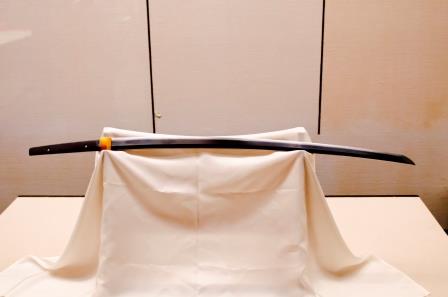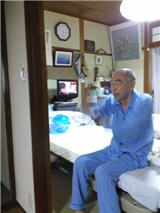You Got It!
How Does Kendo Discipline The Human Character?
Do You Know What Kendo Is?
Kendo to me is different from what kendo is to you. Some people do kendo as their hobby, some people do kendo as their occupation and some people do kendo to maintain their health.
Some do kendo because they have
high respect towards samurai. Whatever the reason is for you to do kendo, I
think it is cool.
Here I would like to share what kendo can give us. First off, I would like to start with the concept of kendo.
The concept of kendo is “to discipline the human character through the application of the principles of the Katana (sword).” (Ref: International Kendo Federation: Concept of Kendo).
One sentence. Very simple. But I have a question. How do we discipline the human character through the application of the principles of the Katana? Do we really know the principles of the katana? Do we train along the principles of the katana? How do we do that?
Katana…

We are taught to treat bamboo sticks as the real sword. Those bamboo sticks are called shinai and in Chinese characters they are written as “Bamboo Katana”.
And what the “treat” means is the way the real sword is treated by samurai. The sword is not a tool to the kendoists but it is the soul and more important than life.
That is the idea that at least I was taught when I was a child. Walking over a shinai, playing with a shinai…if we did anything else considered disrespectful to the sword, we got told off a lot including smacking in the head or butt.
In kendo, we must carry our shinai in our left hand in the sagetō position and lift it up to the taitō position.
Then we draw out our sword and take our stance. These are based on how to draw a real sword. When swinging we must pay attention to the angel of the shinai because the katana has a blade. Without following those, it is no longer kendo. So kendoists value these.
This is one of the cultural values that kendo carries. It is saying “kendo is derived from samurai swordsmanship. So we must treat shinai as a real sword.
We are NOT just hitting each other.” It is true and it is very important cultural value of kendo. And it is also historical value of kendo. But just keeping and following these cultural values won’t “discipline the human character”.
So What Disciplines Our Human Character? Is It Hard Training?
I am writing this a day after Uchimura senshu won the 61st All Japan Championship.
I think if he could go back 30 years ago and participate in the 31st All Japan Championships, he would wipe out all the kendoists (my heroes) of the time. Those current kendoists we see in kendo championships now are super athletes with no doubt.
So the competitive side of kendo has improved dramatically. Kendo has become really fast and amazingly competitive for the past three decades. It takes discipline to become that good in kendo. Obviously those kendoists have discipline. And I know kendo is one of the martial arts that demand us a lot.
 Fighting Cancer for His 6-dan Exam
Fighting Cancer for His 6-dan ExamThose kendoists whose goal is to win tournaments or win over their rivals train hard. When I was a teenager, I trained hard so I could win tournaments or defeat my rivals. But in kendo almost everyone trains hard. I remember my father who was in his early 60s was given hard training right in front of my eyes. It was hard enough for the person who started kendo at the age of 55.
I am not familiar with other martial arts so I do not know if it is the same in other martial arts. Certainly it was beyond “recreational sports” for my father (smile).
Hard training drains our physical energy. When we reach to a certain point, our body will try to stop us from moving. Your breathing becomes really fast, you cannot lift your shinai up anymore. You cannot even take a step forward. But as most of people know, kendo training won’t stop there, especially when motodachi is a sensei. They will push you until your mental energy takes over your body. That is when your real training starts.
You are really tired and you do not want to keep going anymore. You just think you should not train anymore. But your motodachi won’t stop. He/she demands you to strike more.
In order for you to keep going, you must use your mental strength, “strong will to keep going”. Through this kind of training, we will know that our physical limitation is not really our limitation and will also develop a sense of “not quitting and keep going”, “patience” and most importantly “confidence”.
This kind of training is a small version of our life. There are moments in our life that we cannot run away from. In such situations, the most important thing we should have is a sense of “not quitting and keep going” and “patience”.
And by training hard in kendo, we can gain “confidence” that we can overcome any kinds of devastating situations.
There are more to learn from this kind of training. We start how we should appreciate those people who give us hard training. Hard training, after all, is for us to improve our mental strength.
I admit that I used to hate my teachers because they gave me really hard training. But one day I noticed that it was only for me to improve my kendo skills AND my personality.
Here is also very important thing to learn. Trust. Senseis give us hard training because they know the hard training will pay off and improve our human characteristics.
When students realize that, a strong bonding is developed between the sensei and students. This is a moment of connection. We all know that as a theory in our brain but it is not the same as really “sunk in”.
We surely need discipline to take hard training and we gain such senses of “not giving up” and “appreciation”. But I still feel lacking something because kendo is “to discipline the human character through the application of the principles of the Katana”.
The principles of the katana, I think, must include teachings from the samurai swordsmanship. The teachings is to connect kendo and our daily life are lacking. Kendo has great teachings from the past.
Those teachings are inherited from generations to generations. Those are not only words that someone came up with. Those are teachings that were learned by real deal-or-alive situations.
Kendo carries these samurai morality and wisdoms. Without teaching or learning these, I do not think we can accomplish “to discipline the human character”.
Ki Ken Tai Icchi for Daily Life
We can explain why “hitting a target” is not the primal goal in kendo. If hitting is the primary goal, ki-ken-tai icchi is not necessary. You must have harmonize your internal energy, your sword and your body.
Your internal energy also means your intention to strike. Your strike must not be an accident. You intend to execute your strike and you must shout a name of the target you aimed at (declaration of your intention).
And your sword must follow your intention in a correct manner of the katana. It is not a stick but a Japanese sword. Your sword, intention and the energy must be integrated. Then your body. You cannot leave your body behind to avoid a cut from your opponent even though you are the one who are executing a cut.
We call it “nige-goshi”. That means your body is ready to retreat. In other words, you are not in the state of sutemi. You are not committed to your cut.
What Does This Tell Us?
In our daily life, we must face to our tasks or problems fair and squire, with a good concentration (a full of energy), with using right tools in right ways (just like using a shinai) and do not think of “making excuses” of the result you get (execute with sutemi i.e. ready to take responsibilities).
And also we must have “zanshin” after striking. Zanshin completes our strike. After an execution of your strike, you should prepare yourself for another fight. You must prepare yourself all the time.
For example, if you are in sales, after selling a product, you should always follow up your customer making sure everything is OK with him/her.
If you are a parent, you must ask yourself if your instruction was right or not after teaching your children something. We cannot simply ignore the situation after our action. This completes our responsibility.
This also means you must go back to the previous state of mind and body. The result of executing your techniques cannot be changed. Whatever the result is, our mind and body must return to the previous position.
We must not be controlled by emotions that might be caused by the result we get from our actions. So zanshin takes us back to our normal “position”.
Learn the Process
Ki ken Tai icchi is also teaching us the process of a valid cut. And it is more important than just “hitting a target”.
If you do the process well, the result should come out well. Of course, we cannot have the perfect process all the time. So we have zanshin; going back to the previous status, which is not affected by the result. It does not matter the result, you must prepare for the next movement.
We must know that Ki Ken Tai Icchi and Zanshin are not only important to get a valid cut, but also learning how things should be done. We are learning this important process of our lives through kendo; Integration of our body, mind and things we use to make things happen for us.
And after our action, we go back to the previous status (zanshin) no matter what the result is. More important thing, with proper zanshin, we can analyse what we did wrong and improve ourselves.
Ki-Ken-Tai-Icchi and Zanshin may be necessary to get a valid cut. But let’s not stop there. If we do not go beyond that, those will become just “rules” of kendo competitions. We must learn from these teachings and apply them to our daily life. Without learning and studying and applying those teachings, kendo will become something different from kendo. Let’s not do that.

